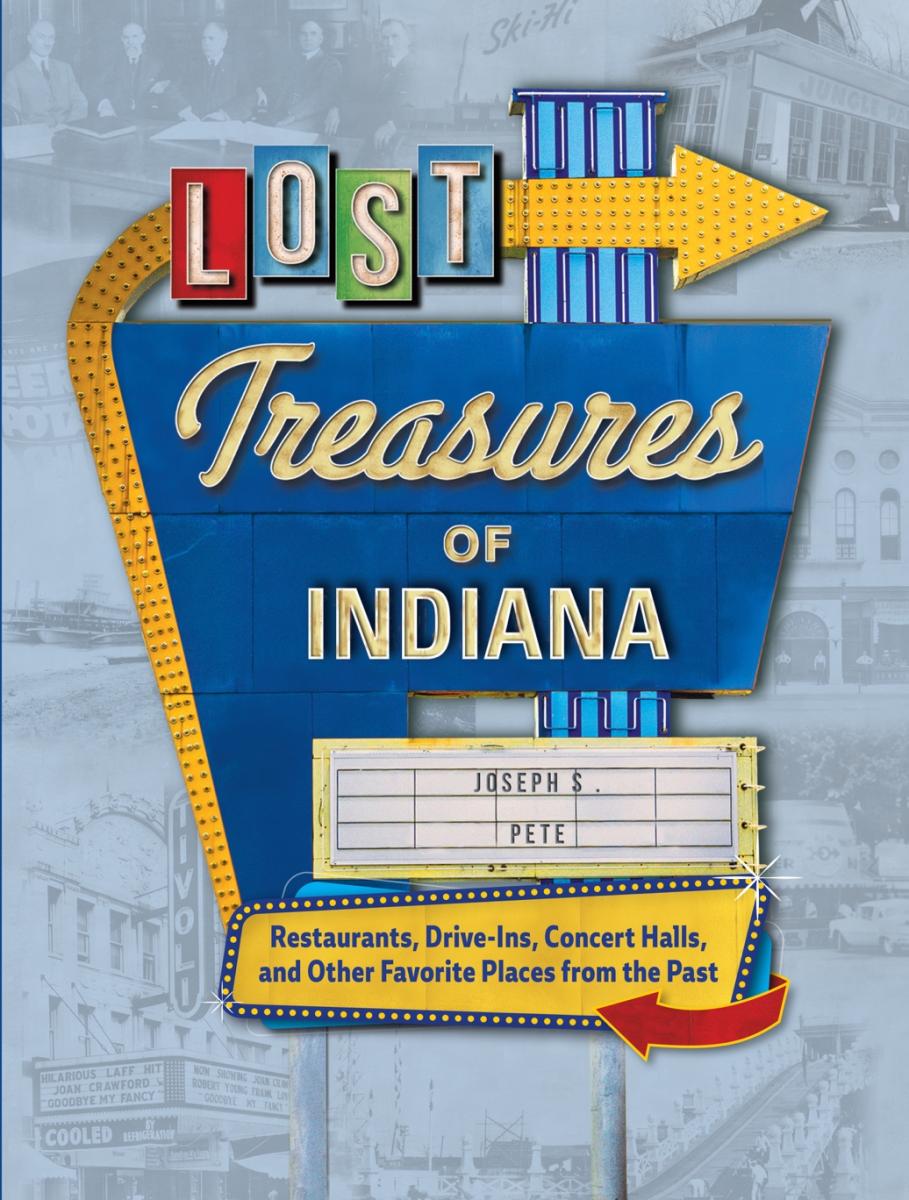
Reedy Press is pleased to announce the release of our newest local interest book, Lost Treasures of Indiana: Restaurants, Drive-Ins, Concert Halls, and Other Favorite Places from the Past, by Joseph S. Pete.
Lost Treasures of Indiana is not another book rehashing the various theories of where the word Hoosier came from or waxing rhapsodic about cornfields, basketball, and pork tenderloin sandwiches.

Author Joseph S. Pete, an award-winning journalist, instead explores lesser-known histories of the Hoosier State, such as the Indianapolis Motor Speedway’s first-ever race that involved hot-air balloons and not race cars, an amusement park that displayed cigarette-smoking bears, or a trolley park that roped in crowds with diving Arabian horses.
The book looks back at ghost towns like Hindostan, miniature towns like Littleville, and underground creeks downtown. It reminisces about familiar favorites like the L.S. Ayres Tea Room, King Cole, Burger Chef, Merrill’s Hi-Decker, Roselyn Bakery, Sammy Terry, and Sauzer’s Kiddieland. It evokes fond memories about bygone institutions from every corner of the Hoosier State like Market Square Arena, the Mesker Park Zoo Monkey House, the Little Nashville Opry, the Lincoln Museum, and the College Football Hall of Fame.
Travel back in time to revisit places like Marsh Supermarkets, Hook’s Drug Stores, and other relics of the past. Learn about how Indiana gave the world laxative water, iconic skyscrapers, and many of the earliest cars to hit the road.
Lost Treasures of Indiana is available wherever books are sold.
Please contact Marla Stoker Ballenger at marla@marqueemediastl.com to arrange an interview or appearance.
Book Details: Lost Treasures of Indiana, by Joseph S. Pete, ISBN: 9781681066066, hardcover, 9 x 12, 192 pages, $42.00
About the Author:
Joseph S. Pete is an award-winning journalist and Times of Northwest Indiana columnist who has written five books about the Hoosier State, including Secret Northwest Indiana. He’s an Indiana University graduate, an Iraq veteran, a longtime Society of Professional Journalists Indiana Pro Chapter treasurer, a frequent guest on Lakeshore Public Radio, and a reporter in northern, central, and southern Indiana. He has traveled every corner of Indiana from Lake Michigan to the Ohio River.
Author Contact:
Joseph S. Pete, jpete@alumni.iu.edu
Upcoming Events:
Presentation and Book Signing
Saturday, October 11, from 11 a.m. – 2 p.m.
Paul Henry's Art Gallery
416 Sibley St, Hammond, IN 46320
(219) 678-5015
Free and open to the public
Book Signing
Saturday, October 18, from 11 a.m. – 3 p.m.
Barnes & Noble
124 US-41 Suite A, Schererville, IN 46375
(219) 287-0070
Free and open to the public
Presentation and Book Signing
Saturday, November 1, from 10 a.m. – 12 p.m.
Hammond Public Library
564 State St, Hammond, IN 46320
(219) 931-5100
Free and open to the public
Book Signing
Saturday, November 29, from 5 – 8 p.m.
Fusion 54
101 W Main St, Crawfordsville, IN 47933
(765) 307-3058
Free and open to the public
Book Signing
Saturday, December 6, from 12 – 4 p.m.
Eugene and Marilyn Glick Indiana History Center
450 W Ohio St, Indianapolis, IN 46202
(317) 232-1882
Free and open to the public
Talking Points:
Over the years, Indiana has been home to many bygone places like
- A fine-dining restaurant atop a skyscraper where the acclaimed chef Wolfgang Puck started his career.
- A balloon race that pre-dated auto racing at the Indianapolis Motor Speedway and inspired the Wonder Bread logo.
- A baseball stadium that inspired the famed ivy on the outfield walls at Wrigley Field.
- A motorcycle race that ended up giving Harley-Davidson motorcycles the nickname "hog."
- A 20-foot-tall Frankenstein monster outside a roadside hot dog joint with–get it–a frank and a stein of root beer.
- A powerful laxative that was shipped around the country to assist in those cases “when nature won’t.”
- An amusement park with Arabian diving horses so novel the son of the emperor of China visited to see them.
- The limestone quarry that raised up the Empire State Building.
- A zoo’s “monkey ship” replicating Christopher Columbus’s Santa Maria that was so novel it was alluded to in Vladimir Nabokov's “Lolita.”
- A notorious honkytonk that kept Siberian tigers, mountain lions, bears and monkeys on the grounds.
What inspired the book?
As an Indiana native, I fondly recall growing up with bygone landmarks like Sauzer’s Kiddieland, Woodmar Mall, Hegewisch Records, and Celebration Station in Northwest Indiana that live on in lore and people still romanticize today. Outside of a stint in the Army, I’ve lived most of my life in the Hoosier State–in northern, central and southern Indiana. I cherish places I frequented at Indiana University that are no longer around, including Plan 9 Video, the Cinemat, the Von Lee, Laughing Planet, and Bear’s Place. I retain a strong nostalgia for Indianapolis institutions I went to when I lived in
Indy, such as MacNiven’s, Acapulco’s Joes, or the Elbow Room.
I previously wrote four books at Northwest Indiana, including Secret Northwest Indiana and 100 Things to Do in Gary and Northwest Indiana Before You Die for St. Louis-based Reedy Press. When Reedy Press called to ask me if I’d be interested in writing Lost Treasures of Indiana for their Lost Treasures series, the concept appealed to me right away. I’ve often found myself not only nostalgic for places I’ve made memories at but places that came and went before I was born. The past just has a magnetic pull for me. In writing this book, I wanted to celebrate the defunct, the disused, the discontinued, and the deceased. I grew up outside Gary, Indiana, where so much was abandoned and have always believed we need to be better custodians of our past.
What was the process for writing this book?
I’ve worked as a journalist in northern, central, and southern Indiana and written four previous books about Northwest Indiana: two history books and two travelogues. I’ve traveled all over Indiana and visited many of the state’s museums, including ones that have bitten the dust, regularly read several of the state’s newspapers, and have read many volumes of Indiana history. I’ve amassed a working knowledge of many of the state’s bygone landmarks, such as the Monon Railroad, the Little Nashville Opry, or Pembroke Arcade, Tomlinson Hall, Market Square Arena, or English Opera House Indianapolis. While some lost landmarks immediately jumped to mind, I made sure I was being sweeping and comprehensive by surveying historical societies in every corner of the state. I checked with local museums, libraries, newspapers, and other sources to best capture the Hoosier State’s lost treasures.
Who is the target audience for the book?
This book is intended for anyone from Indiana or with any connection to Indiana or interest in Midwestern history in particular or American history in general. It’s for native Hoosiers, transplants, people who passed through, maybe to go to college, or anyone who wants to learn more about the state’s rich history. This book will kindle nostalgia for familiar favorites like Sammy Terry, the Hoosier Dome, the Star Plaza Theater, the Strongbow Inn, the Irish Lion, Roselyn Bakery, and Tin Star, but also potentially can teach everyone something new.
What are little known facts about Indiana history?
Indiana is known for having produced many of the first automobiles and of course auto racing, though the first race that ever took place at the Indianapolis Motor Speedway involved balloons. The Hoosier State is known for being one of the most manufacturing intensive in the country, but not everyone realizes its the steel capital, the orthopedic capital, the casket capital, the RV capital, and even the goldfish capital. Indiana is known for its love of basketball but not everyone knows it’s home to 10 of the 12 largest high school basketball gyms in the country. I learned so much about Indiana while writing this book. I for instance had heard of the Wonderland Amusement Park but didn’t know it roped them in with cigarette-smoking bears or for that matter how many concert halls, bars, malls, tattoo parlors and other venues drew customers with bears, lions, tigers, and other exotic animals over the years.
What are some of the Hoosier State’s most unique lost treasures?
My book chronicles lost treasures in every corner of Indiana from Lake Michigan to the Ohio River. It covers everything from the Limberlost Swamp that was drained to the area where Elvis played his final concert to the high school where James Dean studied. Indiana made one of the bestselling laxative waters, produced cherished institutions like the grand L.S. Ayres department store and its famed tea room, and, and helped launch the careers of the likes of Hank Aaron, Wayne Gretzky and Wolfgang Puck. These lost landmarks aren’t just buildings or places–they’re repositories of people’s memories, of people’s stories. As a kid, I remember frequently places like the Town Theatre in Highland, where the delightfully, charmingly eccentric owners showed arthouse films that were interrupted midway through with the curtains closing for an intermission in which they served coffee and cake. After the owners died, the town later bought it in an auction, outbidding local movie theater operators. They wanted to turn it into a performing arts venue. But a new council got elected, the town changed direction, and the historic movie theater where so many memories were made was torn down. I hope my book will inspire people to appreciate such landmarks that were lost and hold on to and cherish the ones we have.
